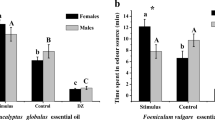Abstract
Comparative study of the headspace (HS) composition from olive leaves, olives of varying degrees of ripeness, and crushed olives revealed significant quantitative and qualitative differences. Three different methods were employed to test the effect of the substances identified on the behavior ofDacus oleae gravid females. Attractive/repellent features were tested by presenting the insects with olfactory choices of a water solution of the test chemicals examined, water (blank), and a highly attractive (control) solution of olive maceration water (MW). Toluene and ethylbenzene, present in leaf and half-ripe olive HIS proved attractive, while (E)-2-hexenal emitted by the crushed olives was found to be decidedly repellent. An oviposition stimulation/deterrence test was carried out on olives placed in proximity to test chemicals under examination in water solution, with olives from the same crop serving as control. In the oviposition testα-pinene, mostly emitted by the leaves and half-ripe olives, emerged clearly as an activant,p-xylene, myrcenone, ethylbenzene,n-octane ando-xylene as weak activants. (E)-2-hexenal and hexanal, both emitted by the crushed olives, displayed an oviposition deterrent effect. The highly repellent property of (E)-2-hexenal was again confirmed in this test.
Similar content being viewed by others
References
Bateman, M.A. 1972. The ecology of fruit flies.Annu. Rev. Entomol. 17:493–518.
Cavalloro, R. (ed.). 1982. Fruit flies of economic importance. Proceedings, CEC/IOBC Symposium, Athens. Balkema, Rotterdam, 642 pp.
Cirio, U. 1971. Reperti sul meccanismo stimolo-risposta nella ovideposizione delDacus oleae Gmel.Redia 52:577–600.
Cirio, U., Vita, G., Fedeli, E., andJacini, G. 1977. L'uso di sostanze naturali presenti nell'oliva come prospettiva di lotta contro ilDacus oleae (Gmel.).Boll. Lab. Entomol. Agric. Portici 34:55–61.
Duncan, D.B. 1955. Multiple range and multiple F tests.Biometrics 11:1–42.
Fedeli, E., Jacini, G., Barone, D., andFavini, G. 1973a. Sui componenti odorosi dell'olio d'oliva. Nota II.Chim. Ind. 55:681–686.
Fedeli, E., Barone, D., andJacini, G. 1973b. Sui componenti odorosi dell'olio d'oliva. Nota III.Riv. Ital. Sost. Grasse 50:38–44.
Fiesta Ros De Ursinos, J.A., Graciani Constante, E., Maestro Duran, N., andVasquez Roncero, A. 1972. Etude d'un attractif naturel pourDacus oleae.Ann. S.E.F.(N.S.) 8:179–188.
Fletcher, B.S. 1987. The biology of dacine fruit fliesAnn. Rev. Entomol. 32:115–144.
Gariboldi, P., Jommi, G., Rossi, R., andVita, G. 1982. Studies on the chemical constitution and the sex pheromone activity of volatile substances emitted byDacus oleae.Experientia 38:441–444.
Gariboldi, P., Verotta, L., andFanelli, R. 1983. Studies on the sex pheromone ofDacus oleae. Analysis of the substances contained in the rectal glands.Experientia 39:502–505.
Girolami, V., Pellizzari, G., Ragazzi, E., andVeronese, G. 1974. Prospects of increased egg production in the rearing ofDacus oleae Gmelin by the use of chemical stimuli. Proceedings of the Symposium: Sterility Principle of Insect Control, IAEA, Vienna, 1975, pp. 209–217.
Girolami, V., Vianello, A., Strapazzon, A., Ragazzi, E. andVeronese, G. 1981. Ovipositional deterrents inDacus oleae (Gmelin).Entomol. Exp. Appl. 29:177–188.
Girolami, V., Strapazzon, A., andDe Gerloni, P.P. 1982. Insect-plant relationship in olive flies: General aspects and new findings, pp. 258–267,in R. Cavalloro (ed.). Fruit Flies of Economic Importance, Proceedings of the CEC/IOBC International Symposium, Athens. Balkema, Rotterdam.
Hatanaka, A., Kajiwara, T., andSekiya, J. 1976. Biosynthesis of trans-2-hexenal in chloroplasts fromThea sinensis, Phytochemistry 15:1125–1126.
Levinson, H.Z., andLevinson, A.R. 1984. Botanical and chemical aspects of the olive tree with regards to fruit acceptance byDacus oleae (Gmelin) and other frugivorous animals.Z. Angew. Entomol. 96:136–149.
Metcalf, R.L. 1990. Chemical ecology of Dacinae fruit flies (Diptera: Tephritidae).Ann. Entomol. Soc. Am. 83:1017–1030.
Montedoro, G., Bertuccioli, M., andAnichini, F. 1978. Aroma analysis of virgin olive oil by head space (volatiles) and extraction (polyphenols) techniques, pp. 247–280,in G. Chaharaiamboulos (ed.). Flavour of Foods and Beverages, Chemistry and Technology. Academic Press, New York.
Nabeta, K., Matsuo, T., andSugisawa, H. 1988. Analysis of volatiles from olive (Olea europaea L.).Res. Bull. Obihiro Univ. 15:293–299.
Panizzi, L., andScarpati, M.L. 1960. Costituzione della oleuropeina, glucoside amaro e ad azione ipotensiva dell'olivo. Nota II.Gazz. Chim. Ital. 90:1449–1485.
Prokopy, R.J. 1977. Stimuli influencing trophic relations in Tephritidae.Colloq. Int. CNRS 265:305–336.
Schulze, K., Haufe, G., andKohler, G. 1989. Formale En-Chlorierung von Myrcen mittels N-Chlor-succinimids.Z. Chem. 5:167–168.
Vita, G., andBarbera, F. 1976. Aspetti biochimici del rapporto piantainsetto nelDacus oleae (Gmel.).Atti XI Congr. Ital. Entomol. 151–161.
Vita, G., andCirio, U. 1977. Testing the response ofDacus oleae to oviposition deterring substances. Quality control, an idea book for fruit fly workers; E.F. Boller and D.L. Chambers (eds.). Bulletin of SROP WPRS.
Vita, G., andCirio, U. 1980. Fruit fly control by chemical attractant and repellents.Boll. Lab. Entomol. Agric. 37:127–139.
Von Schantz, M., Widen, K.G., andHiltunen, R. 1973. Structures of some aliphatic monoterpenoids isolated from the essential oil ofLedum palustreL.Acta Chem. Scand. 27:551–555.
Author information
Authors and Affiliations
Rights and permissions
About this article
Cite this article
Scarpati, M.L., Scalzo, R.L. & Vita, G. Olea europaea Volatiles attractive and repellent to the olive fruit fly (Dacus oleae, Gmelin). J Chem Ecol 19, 881–891 (1993). https://doi.org/10.1007/BF00985017
Received:
Accepted:
Issue Date:
DOI: https://doi.org/10.1007/BF00985017




